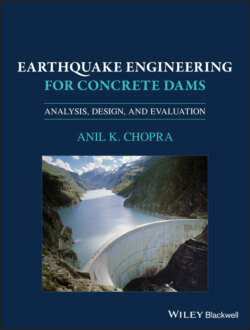Читать книгу Earthquake Engineering for Concrete Dams - Anil K. Chopra - Страница 17
1.3.3 Limitations of Traditional Procedures
ОглавлениеIt is apparent from the preceding discussion that the dynamic stresses that develop in gravity dams bear little resemblance to the results obtained from traditional static design procedures. In the case of Koyna Dam, no tensile stresses were expected when designing the dam for earthquake forces based on a seismic coefficient of 0.05, uniform over the height; however, the earthquake caused significant tensile cracking in the dam. This discrepancy is the result of using too small a seismic coefficient and not recognizing the amplification of acceleration over the height of the dam.
The typical design seismic coefficients, 0.05–0.10, are much smaller than the ordinates of design spectra for intense earthquake motions in the range of vibration periods for concrete gravity dams (Figure 1.3.2). Note that the seismic base shear coefficient values for dams are similar to those specified for multistory buildings. However, building code design provisions have been based on the premise that buildings should be able to: “(i) resist minor earthquakes without damage; (ii) resist moderate earthquakes without structural damage; and (iii) resist major earthquakes…without collapse but with some structural…damage.” While these may be appropriate design objectives for buildings, major dams should be designed more conservatively, and this intended conservatism is reflected in the no‐tension requirement imposed in traditional methods for designing dams. What the traditional methods fail to recognize, however, is that this requirement must be tied to the dynamic response of the dam that is influenced by its natural vibration periods and modes.
Figure 1.3.1 Maximum principal stresses in Koyna Dam at selected time instants due to transverse and vertical components of ground motion recorded during the December 11, 1967 earthquake; initial static stresses are included.
Figure 1.3.2 Comparison of uniform hazard spectrum and seismic coefficient for concrete dams and buildings.
Source: Adapted from Chopra (1978).
The effective modal earthquake forces may be expressed as the product of the weight of the dam per unit height and a seismic coefficient; its magnitude depends on the pseudo‐acceleration spectral ordinate at the modal period and its height‐wise distribution depends on the shape of the mode. The response of short‐vibration‐period structures, such as concrete gravity dams, is dominated by the fundamental mode of vibration, and the seismic coefficient varies over the dam height, as shown schematically in Figure 1.3.3b. In contrast, traditional analysis and design procedures ignore the dynamic amplification of response, as reflected in the response spectrum and the shape of the mode, and adopt a uniform distribution for the design coefficient (Figure 1.3.3a), resulting in an erroneous distribution of lateral forces and hence of stresses in the dam. The implications of these errors will be discussed in Chapter 7.
To eliminate these errors, it is imperative to consider the dynamics of the system subjected to realistic ground motions in estimating the earthquake response of concrete dams. In Chapters 2–6, such procedures for dynamic analysis of 2D models of gravity dams are developed. In Chapter 7, responses computed by these procedures are demonstrated to be consistent with motions of a gravity dam recorded during an earthquake and with the earthquake performance of Koyna (gravity) Dam.
The traditional design loadings for gravity dams include seismic water pressures in addition to the hydrostatic pressures, as specified by various formulas (U.S. Army Corps of Engineers 1958; Bureau of Reclamation 1966). These formulas differ somewhat in detail and in numerical values but not in underlying assumptions; they are all based on the classical results (Westergaard 1933; Zangar 1952) derived from analyses that assumed the dam to be rigid and water to be incompressible. One of these formulas specifies the seismic water pressure pe = cswH, where c is a coefficient that varies from zero at the water surface to about 0.7 at the reservoir bottom, s is the seismic coefficient, w is the unit weight of water, and H is the total depth of water. For a seismic coefficient of 0.1, the additional water pressure at the base of the dam is about 7% of the hydrostatic pressure; and pressure values at higher elevations are even smaller. As a result, these additional water pressures have little influence on the computed stresses and hence on the geometry of the gravity section that satisfies the traditional design criteria.
Figure 1.3.3 Distribution of seismic coefficients over dam height in traditional design and for the fundamental vibration mode.
Source: Adapted from Chopra (1978).
On the other hand, earthquake‐induced stresses in gravity dams are much larger when dam–water interaction arising from deformations of the dam and water compressibility effects are considered, as will be demonstrated in Chapters 2 and 6. It is apparent, therefore, that hydrodynamic effects are considerably underestimated because of assumptions implicit in traditional design forces.
As mentioned earlier, traditional analysis and design procedures ignore interaction between the dam and foundation. However, such interaction has very significant influence on the dynamics of the system, and, hence, on the earthquake‐induced stresses. This will be demonstrated in Chapters 3 and 6.
Finally, the static overturning and sliding criteria that have been used in traditional design procedures for gravity dams have little meaning in the context of oscillatory response to earthquake motions.
